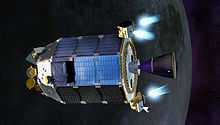Kepler-87c
| Extrasolar planet | List of extrasolar planets | |
|---|---|---|
| Parent star | ||
| Star | Kepler-87 (KOI 1574) | |
| Constellation | Cygnus | |
| Right ascension | (α) | 19h 51m 40.05s |
| Declination | (δ) | +46° 57′ 54.5″ |
| Apparent magnitude | (mV) | 14.6 |
| Mass | (m) | 1.1 (±0.05) M☉ |
| Radius | (r) | 1.82 (±0.04) R☉ |
| Temperature | (T) | 5600 (± 50) K |
| Metallicity | [Fe/H] | −0.17 (± 0.03) |
| Age | 7–8 Gyr | |
| Physical characteristics | ||
| Mass | (m) | 6.4±0.8 M⊕ |
| Radius | (r) | 6.14±0.29 R⊕ |
| Density | (ρ) | 0.152 g cm−3 |
| Temperature | (T) | 400 |
| Orbital elements | ||
| Semimajor axis | (a) | 0.664 AU |
| Eccentricity | (e) | 0.039 |
| Orbital period | (P) | 191 d |
| Inclination | (i) | 89.588° |
| Discovery information | ||
| Discovery date | 8 October 2013 | |
| Discoverer(s) | Ofir et al. | |
| Discovery method | Transit (Kepler Mission) | |
| Other detection methods | Transit-timing variation | |
| Discovery status | Submitted | |
| Other designations | ||
| KOI 1574.02
| ||
Kepler-87c is a planet orbiting Kepler-87, a star slightly more massive than the Sun and nearing the end of its main-sequence period.
Characteristics
Despite being larger than Neptune, Kepler-87c is only about 6.4 times more massive than Earth. This means that its density is only 0.152 g/cm3. This is the first planet with a comparable mass to have such a low density. Its equilibrium temperature is 130 °C.[1]
References
- ↑ An Independent Planet Search In The Kepler Dataset. II. An extremely low-density super-Earth mass planet around Kepler-87: Aviv Ofir, Stefan Dreizler, Mathias Zechmeister, Tim-Oliver Husser
External links
| ||||||||||||||||||||||||||||||||||||||||||||||||||||||||
| |||||||||||||||||||||||||||||||||||||||||||
